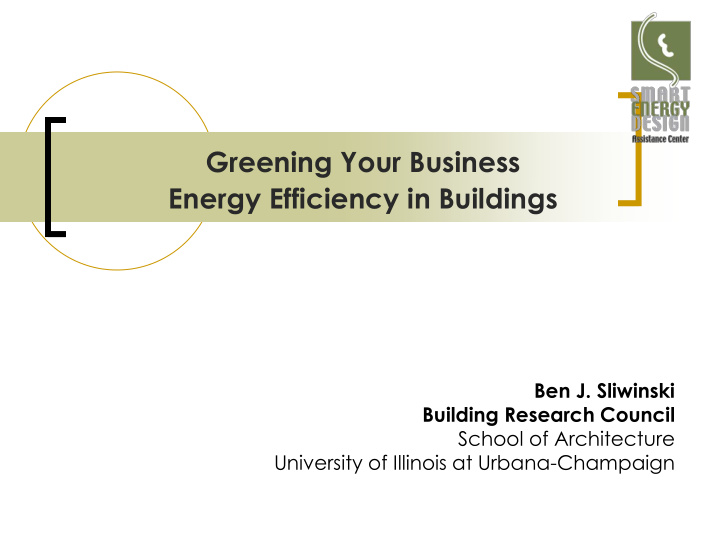



Greening Your Business Energy Efficiency in Buildings Ben J. Sliwinski Building Research Council School of Architecture University of Illinois at Urbana-Champaign
Overview Introduction – Where is the Money? A Little About SEDAC Energy Efficiency Opportunities
About the Money… DCEO – Public Sector Electric Efficiency Program – now called Illinois Energy Now. Ameren Illinois – Act on Energy ComEd – Smart Ideas
SEDAC Background Since starting in 2005 SEDAC has completed about 720 Energy Audits with report. 58 million sf of buildings audited, 10 million sf of audit projects on the books currently About 31 percent energy cost savings on average Have audited a wide variety of building types
SEDAC Levels of Service Level 1 Telephone or E-mail Consultation on Energy Issues Level 2 and 3 Energy Audits and Design Assistance Level 4 Implementation Support All levels of service are free of charge to eligible clients
Typical SEDAC L3 Service Design Review and/or Site Inspection Computer Modeling of Base Case and Alternatives with ECRMs Energy Savings Analysis Life Cycle Cost Analysis Final Report with Recommendations
What SEDAC Needs From You A completed application (for Level 2, 3 and 4 services). Building Plans (paper, pdf, CAD, back of envelope). Utility Bills (for existing buildings). Your time during our site visit (as necessary), and follow-up meeting.
Quick Sample of Buildings Audited
A Variety of Building Types -
High Rise
Restaurants and Ice Rinks?
Manufacturing and Libraries
Energy Efficiency Opportunities
Benchmarking (Is it a Hog?) Use your energy bills to estimate: $/sf per year (quick and dirty use with caution) around $1/sf to $2/sf = good $2 to $3/sf = fair to slightly poor (typical) $3 to $4/sf = probably room for improvement $4/sf and above = oink (unless there is a process) kBtu/sf per year – more accurate than dollar metric – can use TargetFinder
Simple Graphs Trouble Shooting with therms 10,000 12,000 14,000 2,000 4,000 6,000 8,000 0 Jan-07 Feb-07 Mar-07 Apr-07 May-07 Jun-07 Jul-07 Aug-07 Sep-07 Oct-07 Nov-07 Dec-07
How Buildings Use Energy Building Envelope (Walls, Roof, Windows, Floors) Lighting Heating, Ventilating, and Air Conditioning (HVAC) Internal and Process Loads (cooking, hot water, swimming pools, manufacturing, etc.)
Compact Fluorescent
Super T8 and Low Wattage T8 Super T8 systems can produce energy savings as high as 40 percent over standard T8. To identify a Super T8, look for lamps that are at least 3100 initial lumens [as opposed to 2850 for a standard T8] and have a barrier coat design and high lumen maintenance. Super T8 lamps include the SYLVANIA "Xtreme ," Philips "Advantage" and GE "HL ." Ballasts include the SYLVANIA "Xtreme," Advance "Optanium," Universal Triad "HE" and GE "UltraMax.
Occupancy Sensors Use them for office lighting Restroom lighting Storage Areas Mechanical Rooms Warehouse Aisles - Fluorescent Get creative – use for HVAC in individual rooms or zones.
Isole – Personal Occupancy Sensor
LED Exit Signs Payback is quick Rebates available Very basic lighting energy savings measure Chicago approved
HID to Fluorescent Retrofit Existing System: 400watt High Pressure Sodium and 400watt Metal Halide. Each fixture uses 455 watts (400 for lamp, 55 for ballast) Retrofit Each fixture uses 234 watts (lamps and ballast combined) Light levels increased 10-20%
Street and Parking Lot Lighting Probe Start HID to Pulse Start HID a typical retrofit. Fluorescent Induction, and LEDs making moves into market
Probe vs. Pulse Start
LED Traffic Signals Application is very popular Energy savings 50 to 75 percent Good LED application: directed light and switched on and off
LED Street Lighting – DOE I-35 Minneapolis Gateway Study The LED luminaires offered a conservative 13% energy savings relative to the baseline HPS system. Simple payback was found to be quite long at current luminaire pricing. Overall public reaction to the LED bridge lighting has been very positive, with “positive” comments outweighing “negative” comments by about five-to-one.
Other DOE Gateway Results http://www1.eere.energy.gov/buildings/ssl / Supermarket Parking Lot Oakland Street lighting – 70 percent savings – 5 15 year payback year payback
Programmable Thermostats They work when you use them. Consider Internet enabled thermostats as retrofits
VAV Supply Air Temp. Reset Saves cooling energy Saves reheat energy Increases hours when economizer can be utilized.
VAV Fans Static Pressure Reset on VAV Systems. Provides significant fan energy savings since system is often at part load Reduces fan noise
VAV Control Deadband “ Variable air volume (VAV ) terminal units shall be programmed to operate at the minimum airflow setting without addition of reheat when the zone temperature is within the set deadband.” To meet this requirement, the control system must allow separate heating and cooling setpoints that are at least 5°F apart. If, for example,the cooling setpoint is 75°F, then the control system cannot enable the reheat coil until the space temperature drops to 70°F or below.
Demand Control Ventilation
Variable Frequency Drives Variable Frequency Drives can save 20 percent or more in electrical usage. Often there are additional benefits in process control and quality. Fans and Pumps both HVAC and process are key applications for VFD.
To Apply for SEDAC Assistance Call 1-800-214-7954 or, Visit the SEDAC web site at www.sedac.org and download an application.
Recommend
More recommend